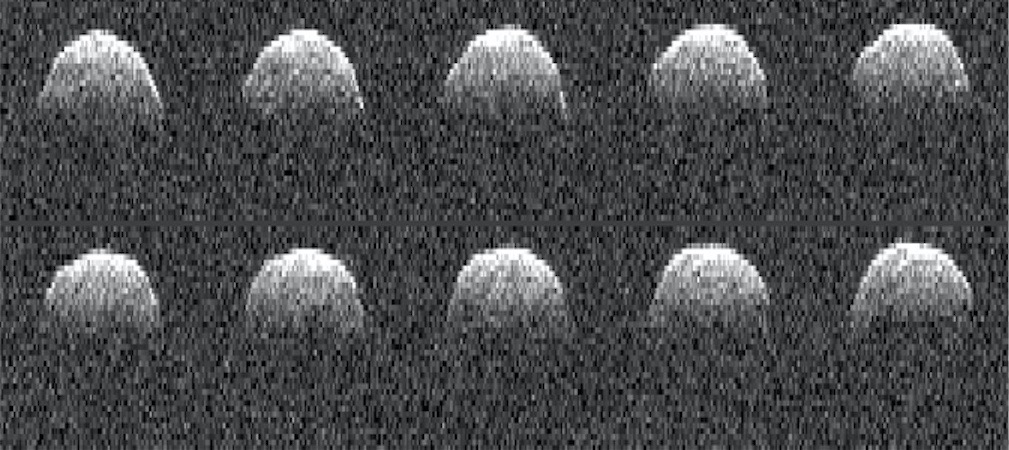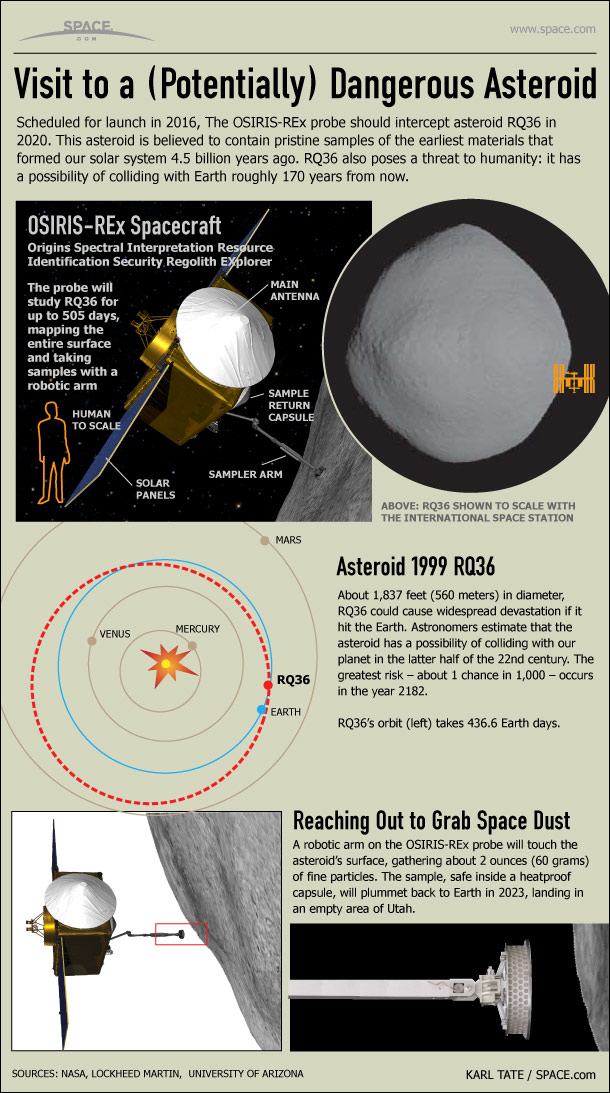
CAPE CANAVERAL, Fla. — What's so special about Bennu?
NASA had literally thousands of potential targets for its asteroid-sampling OSIRIS-REx mission, which is scheduled to launch Thursday (Sept. 8) from Cape Canaveral Air Force Station here. But the agency decided on a space rock named Bennu, because the asteroid checks off three important boxes.
"Bennu's size, primitive and carbon-rich composition and orbit make it one of the most fascinating and accessible asteroids, and that is why it was ultimately chosen as the target asteroid for the OSIRIS-REx mission," Christina Richey, OSIRIS-REx deputy program scientist at NASA Headquarters in Washington, D.C., said during a news conference Tuesday (Sept. 6). [Osiris-Rex: NASA's Asteroid Sample-Return Mission in Pictures]
The main goal of the $800 million OSIRIS-REx mission (whose name is short for Origins, Spectral Interpretation, Resource Identification, Security, Regolith Explorer) involves learning more about the role asteroids may have played in seeding Earth (and perhaps other worlds) with the building blocks of life.
If all goes according to plan, OSIRIS-REx will arrive at Bennu in August 2018, grab at least 2 ounces (60 grams) of asteroid material two years later and return this sample to Earth in September 2023.
Snagging samples from an asteroid in deep space is a tricky operation under any circumstances, but it's especially difficult when the space rock is less than 660 feet (200 meters) or so wide, Richey said. That's because small asteroids rotate fast — sometimes fast enough to fling material off the surface, leaving little stuff for a visiting probe to grab.
"Furthermore, it's difficult [for a spacecraft] to match the rotation speed of a rapidly rotating object," Richey said.
Get the Space.com Newsletter
Breaking space news, the latest updates on rocket launches, skywatching events and more!
But Bennu is nearly 1,640 feet (500 m) in diameter, and it rotates just once every 4.3 hours — slowly enough that OSIRIS-REx should be able acquire samples via a "safe, smooth, slow high-five" of the surface, she added.
The nearly spherical asteroid is also quite accessible, thanks to a relatively Earth-like orbit. Bennu completes one lap around the sun every 1.2 years and comes into Earth's neighborhood every six years, Richey said. In addition, the asteroid's orbit is inclined by just 6 degrees compared to that of Earth.
"So it really is optimal for accessibility, for the spacecraft to go to and then return from" in a relatively short amount of time, Richey said.
Then there's the composition.
Bennu "has a very dark, black surface that we think indicates high concentrations of carbon, and hopefully in the form of organic material," OSIRIS-REx principal investigator Dante Lauretta, of the University of Arizona, told Space.com last month.
"We're really interested in bringing back a pristine sample of the early solar system," he added. "Did these kinds of bodies [like Bennu] deliver organic material and water, in the form of hydrated minerals like clay, to the surface of our planet that created the habitability and the environments that may have led to the origin of life?"

But Bennu wasn't the only asteroid that met all of these necessary criteria. In fact, the OSIRIS-REx team eventually identified five suitable finalists, Lauretta said.
"We selected asteroid Bennu as the final target of OSIRIS-REx because it was so well characterized, with the radar data and telescopic data, that we felt that really reduced risk to the mission profile," he said during Tuesday's news conference.
Indeed, Bennu, which was discovered in 1999, is the best-understood near-Earth asteroid that has never been visited by a spacecraft, Richey said.
Bennu offers some bonus perks as well. It's classified as a potentially hazardous asteroid, and there's a slight chance it could slam into Earth in the late 22nd century, scientists have said. OSIRIS-REx's observations will allow researchers to fine-tune their understanding of Bennu's orbit, and thus the threat it poses to Earth, Lauretta said. The mission should also shed light on the forces that can nudge an asteroid this way and that along its trajectory, Lauretta said.
One such force comes from the solar energy that asteroids radiate away as heat, in a phenomenon known as the Yarkovsky effect.
"When that happens, it acts like a thruster and changes the trajectory of the asteroid," Lauretta told Space.com in August. "If you want to be able to predict where an object like Bennu is going to be in the future, you have to account for this phenomenon, and we're going to provide the best-ever scientific investigation of this fascinating concept."
Follow Mike Wall on Twitter @michaeldwall and Google+. Follow us @Spacedotcom, Facebook or Google+. Originally published on Space.com.
Join our Space Forums to keep talking space on the latest missions, night sky and more! And if you have a news tip, correction or comment, let us know at: community@space.com.

Michael Wall is a Senior Space Writer with Space.com and joined the team in 2010. He primarily covers exoplanets, spaceflight and military space, but has been known to dabble in the space art beat. His book about the search for alien life, "Out There," was published on Nov. 13, 2018. Before becoming a science writer, Michael worked as a herpetologist and wildlife biologist. He has a Ph.D. in evolutionary biology from the University of Sydney, Australia, a bachelor's degree from the University of Arizona, and a graduate certificate in science writing from the University of California, Santa Cruz. To find out what his latest project is, you can follow Michael on Twitter.









